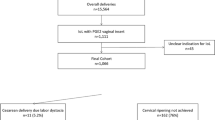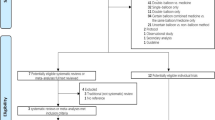Abstract
Background
Membrane sweeping (MS) could increase the likelihood of spontaneous labor within 48 h. However, the rationale for performing routinely an intervention with the potential to induce labor in women with an uneventful pregnancy at 38 weeks of gestation is, at least, questionable. We conducted a meta-analysis of randomized controlled trial (RCT) studies to assess evaluated the effect of MS added to formal induction method on the spontaneous vaginal delivery, compared with formal induction alone.
Methods
PubMed, Embase, Cochrane Library databases, Web of Science, and Clinical Trials were searched from their inception to March 8, 2017. We estimate summarized relative risk (RR) and 95% confidence intervals (CIs) for dichotomous outcomes. The primary outcome was vaginal delivery, and second outcomes (side effects of MS) included meconium-stained liquor, admission to the neonatal unit, instrumental delivery.
Results
Four RCTs with a total of 1377 participants were identified. The summary RR in the overall group was 1.12 (95% CI 1.05–1.18), with moderate heterogeneity (P = 0.22, I2 = 33%). The summary RR in the nulliparas’ subgroup was 1.32 (95% CI 1.18–1.48), with no heterogeneity (P = 0.79, I2 = 0%). MS did not increase the risk of side effects.
Conclusions
MS added to formal induction significantly increased vaginal delivery rates, especially in nulliparas compared with formal induction alone. Notably, there are no obvious side effects of MS. Meanwhile, more RCTs studies are needed to investigate the side effects of MS on instrumental delivery, postpartum hemorrhage, and cervical laceration.




Similar content being viewed by others
References
Tan PC, Jacob R, Omar SZ (2006) Membrane sweeping at initiation of formal labor induction: a randomized controlled trial. Obstet Gynecol 107(3):569–577. https://doi.org/10.1097/01.AOG.0000200094.89388.70
Gabbay-Benziv R, Hadar E, Ashwal E, Chen R, Wiznitzer A, Hiersch L (2016) Induction of labor: does indication matter? Arch Gynecol Obstet 294(6):1195–1201. https://doi.org/10.1007/s00404-016-4171-1
Thiery M, Baines CJ (1989) The development of methods for inducing labor. In: Chalmers I, Enkin M, Keirse M (eds) Effective care in pregnancy and childbirth. Oxford University Press, Oxford, pp 969–980
Mitchell MD, Flint AP, Bibby J, Brunt J, Arnold JM, Anderson AB, Turnbull AC (1977) Rapid increases in plasma prostaglandin concentrations after vaginal examination and amniotomy. BMJ 2(6096):1183–1185
McColgin SW, Bennett WA, Roach H, Cowan BD, Martin JN Jr, Morrison JC (1993) Parturitional factors associated with membrane stripping. Am J Obstet Gynecol 169(1):71–77
Chard T, Gibbens GL (1983) Spurt release of oxytocin during surgical induction of labor in women. Am J Obstet Gynecol 147(6):678–680
Boulvain M, Stan C, Irion O (2005) Membrane sweeping for induction of labour. Cochrane Database Syst Rev 1:CD000451. https://doi.org/10.1002/14651858.cd000451.pub2
Hill MJ, McWilliams GD, Garcia-Sur D, Chen B, Munroe M, Hoeldtke NJ (2008) The effect of membrane sweeping on prelabor rupture of membranes: a randomized controlled trial. Obstet Gynecol 111(6):1313–1319. https://doi.org/10.1097/AOG.0b013e31816fdcf3
Ugwu EO, Obi SN, Iferikigwe ES, Dim CC, Ezugwu FO (2014) Membrane stripping to prevent post-term pregnancy in Enugu, Nigeria: a randomized controlled trial. Arch Gynecol Obstet 289(1):29–34. https://doi.org/10.1007/s00404-013-2918-5
Moher D, Liberati A, Tetzlaff J, Altman DG, The PRISMA Group (2009) Preferred reporting items for systematic reviews and meta-analyses: the PRISMA statement. BMJ 339:b2535. https://doi.org/10.1136/bmj.b2535
Higgins JP, Altman DG, Gotzsche PC, Juni P, Moher D, Oxman AD, Savovic J, Schulz KF, Weeks L, Sterne JA, Cochrane Bias Methods G, Cochrane Statistical Methods G (2011) The Cochrane Collaboration’s tool for assessing risk of bias in randomised trials. BMJ 343:d5928. https://doi.org/10.1136/bmj.d5928
Higgins JP, Thompson SG (2002) Quantifying heterogeneity in a meta-analysis. Stat Med 21(11):1539–1558. https://doi.org/10.1002/sim.1186
DerSimonian R, Laird N (1986) Meta-analysis in clinical trials. Control Clin Trials 7(3):177–188
Doany W, McCarty J (1997) Outpatient management of the uncomplicated postdate pregnancy with intravaginal prostaglandin E2 gel and membrane stripping. J Matern Fetal Med 6(2):71–78. https://doi.org/10.1002/(SICI)1520-6661(199703/04)6:2<71:AID-MFM2>3.0.CO;2-M
Foong LC, Vanaja K, Tan G, Chua S (2000) Membrane sweeping in conjunction with labor induction. Obstet Gynecol 96(4):539–542
Al-Harmi J, Chibber R, Fouda M, Mohammed ZK, El-Saleh E, Tasneem A (2015) Is membrane sweeping beneficial at the initiation of labor induction? J Matern Fetal Neonatal Med 28(10):1214–1218. https://doi.org/10.3109/14767058.2014.947951
Martin JA, Hamilton BE, Sutton PD, Ventura SJ, Menacker F, Kirmeyer S, Mathews TJ (2009) Births: final data for 2006. National Center for Health Statistics, Hyattsville, pp 1–118
Sawai SK, O’Brien WF, Mastrogiannis DS, Krammer J, Mastry MG, Porter GW (1994) Patient-administered outpatient intravaginal prostaglandin E2 suppositories in post-date pregnancies: a double-blind, randomized, placebo-controlled study. Obstet Gynecol 84(5):807–810
Hannah ME, Hannah WJ, Hellmann J, Hewson S, Milner R, Willan A (1992) Induction of labor as compared with serial antenatal monitoring in post-term pregnancy. A randomized controlled trial. The Canadian Multicenter Post-term Pregnancy Trial Group. N Engl J Med 326(24):1587–1592. https://doi.org/10.1056/NEJM199206113262402
Takahashi T, Marcus B, Scheerer RG, Katz M (1991) A new model for objective assessment of cervical ripening: the effect of prostaglandin E2 and prelabor contractility. Am J Obstet Gynecol 164(4):1115–1118
Casey C, Kehoe J, Mylotte MJ (1994) Vaginal prostaglandins for the ripe cervix. Int J Gynaecol Obstet 44(1):21–26
Greer IA, McLaren M, Calder AA (1990) Vaginal administration of PGE2 for induction of labor stimulates endogenous PGF2 alpha production. Acta Obstet Gynecol Scand 69(7–8):621–625
Bakker R, Pierce S, Myers D (2017) The role of prostaglandins E1 and E2, dinoprostone, and misoprostol in cervical ripening and the induction of labor: a mechanistic approach. Arch Gynecol Obstet 296(2):167–179. https://doi.org/10.1007/s00404-017-4418-5
Keirse MJ, Thiery M, Parewijck W, Mitchell MD (1983) Chronic stimulation of uterine prostaglandin synthesis during cervical ripening before the onset of labor. Prostaglandins 25(5):671–682
Author information
Authors and Affiliations
Corresponding author
Ethics declarations
Funding
This study was not funded.
Conflict of interest
The authors declare that they have no conflict of interest.
Ethical approval
This article does not contain any studies with human participants or animals performed by any of the authors.
Electronic supplementary material
Below is the link to the electronic supplementary material.
Rights and permissions
About this article
Cite this article
Liu, J., Song, G., Meng, T. et al. Membrane sweeping added to formal induction method to increase the spontaneous vaginal delivery: a meta-analysis. Arch Gynecol Obstet 297, 623–630 (2018). https://doi.org/10.1007/s00404-017-4643-y
Received:
Accepted:
Published:
Issue Date:
DOI: https://doi.org/10.1007/s00404-017-4643-y




